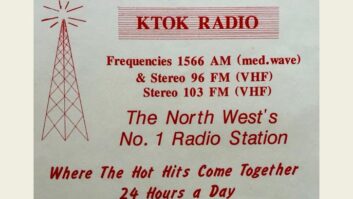Henry’s Broadcast Mixer Fits In Drive Bay, Transforms Computer Into One-Mic Console
(click thumbnail)
Henry Engineering forever endeared itself to radio engineers by creating the Matchbox and bridging the gap between inexpensive consumer audio gear and broadcast equipment. Now, the company’s StudioDrive is designed to serve much the same purpose by bringing personal computers up to snuff.
Product CapsuleTHUMBS UP:
Excellent audio
Controls well thought-out and constructed
Flexible configuration for internal/external install
Good documentation
THUMBS DOWN:
Single mic input
Awkward cable-run from PC with internal installation
PRICE: $675
Contact: Henry Engineering in California at (626) 355-3656 or visit www.henryeng.com
Set up appropriately, StudioDrive will transform a PC or Mac with a pro audio card into a dedicated single-mic radio production console customized for live broadcast and studio production. The computer becomes a complete standalone studio system, with no need for an external mixing board. Just add peripherals – mic, mic processor, telehybrid, CD – and you’re ready for show time.
From the source
The StudioDrive is a two-piece system that consists of an audio interface box and a control unit linked by a ribbon cable. The audio interface is an AC-powered box with an array of 16 1/4-inch TRS jacks laid out 4×4, along with a single Neutrik XLR mic input. Thankfully, a connector map is stenciled alongside the jacks for easy reference, so what you plug in here matches the controls.
With an additional 1/8-inch unbalanced stereo line-in jack on the control unit, the StudioDrive allows for up to six audio sources through four mixing channels. Altogether, there are three stereo-line level inputs, a dedicated PC soundcard input and an integrated telecoupler to interface with audio coming over a standard POTS line. Two pairs of stereo outputs are intended to feed live broadcasting and PC recording. A mix-minus output is included for a telephone hybrid.
The monitor jack is designed to play three things: the program output, the playback from the PC soundcard or off-the-air signals. The audio interface box is made of sturdy heavy-gauge metal and can be wall-mounted or placed anywhere – or at least anywhere within the reach of the 24-inch ribbon cable to the control unit.
The control unit is designed to fit inside a PC drive bay, so it matches the dimensions of a CD or DVD recorder/player. The relatively small amount of space on the front panel holds five in/out buttons to toggle between functions and modes, with six knobs to set levels plus a 1/4-inch stereo headphone jack. The buttons toggle between play/record, program/air and patch in the phone line. These make it simple to switch between on-air and production modes without having to swap out or patch in anything in the audio interface.
As mentioned, the panel includes a 1/8-inch unbalanced line-in jack for input of added sources like a portable MiniDisc.
A four-level LED stereo VU meter keeps track of the action. While internal installation in a PC makes for a tidy setup, an optional desk-mounting kit makes this an external standalone, and allows for tucking the computer away or operation via laptop – options that can keep down PC noise from cooling fans and hard drives, as well as cut RF issues.
Working with the StudioDrive demonstrated to me that the unit is thought out carefully and engineered to do the job for a one-mic studio. For some, it may seem sparse. But what do you need extra knobs and sliders for anyway?
Silent partner
Setup was far from self-explanatory. However the relatively straightforward five-page instructions and circuit diagram were not too difficult to figure out. The trick is in setting the internal jumpers in the control unit mostly to match levels with peripherals and soundcards. These are key for optimizing the audio quality and calibrating the LED VU meters. Additional jumpers in the audio interface box allow for a mic processor insert and a cough switch for the mic.
Connected externally to a generic Pentium 4 PC with a Digital Audio Labs Soundcard Deluxe, the StudioDrive proved to be quiet. The DAL card achieves a 106 dB S/N ratio, and adding this to the audio chain brought it down slightly to just under 100 dB. Remember, that’s connected externally with six feet of balanced cable between the audio interface box and the audio card in the back of the PC.
While internal installation in a drive bay looks great, the inside of a PC is generally a noisy, RF-contaminated environment. Though the StudioDrive boxes are well insulated, there is a chance for picking up static from the hard drives and power supply inside through the ribbon cable to the audio interface box. The company suggests care in keeping the cable away from other data cables and PC boards, but that is problematic, as the typical computer doesn’t give all that much room to maneuver.
Besides, getting the cable out of the box is a jury rig. I used an open card slot in the back. The bottom line is that if you’re fussy about noise, set it up externally. But if you want to clear the clutter, internal installation will do fine.
The StudioDrive is an elegant solution to what is otherwise an awkward undertaking. While great for single mic installations, it would be nice to have a few more mic inputs. That would add enormously to the versatility of what is otherwise an excellent addition to the Henry Engineering line.








